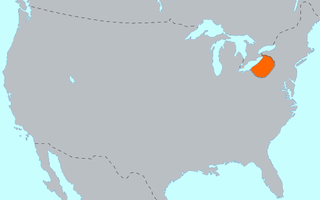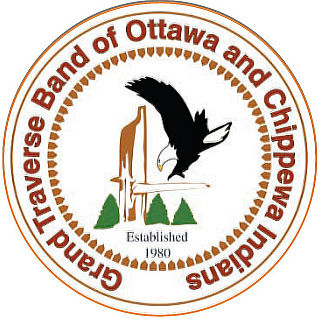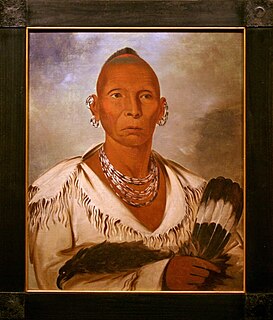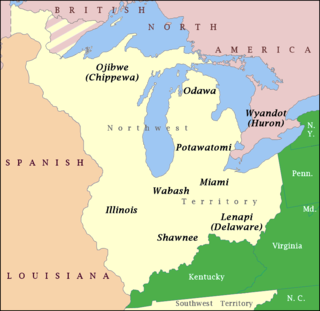 W
WThe Algonquian are one of the most populous and widespread North American native language groups. Historically, the peoples were prominent along the Atlantic Coast and into the interior along the Saint Lawrence River and around the Great Lakes. This grouping consists of the peoples who speak Algonquian languages.
 W
WThe Amikwa, also as Amicouës, Amikouet, etc., were a Native American clan, one of the first recognized by Europeans in the 17th century. The Amikwa were Anishinaabeg peoples, and spoke an Ojibwe language. In the Jesuit Relations, the Amikwa were referred to as the Nez Perce. They inhabited the north shore of Lake Huron, opposite the island of Manitoulin, along the shores between Missisagi and French Rivers, and along Spanish River. In September 1753, Bacqueville de la Potherie claimed that they inhabited the shores of Lake Nipissing. They were a large, powerful group allied with the Nipissings and related to the Outchougai, Mandua, and Atchiligouan peoples. The Amikwa were nearly wiped out by disease and wars with the Iroquois and the last of the tribe appear to have merged with the Nipissings or the Ojibwe.
 W
WThe Anishinaabe are a group of culturally-related Indigenous peoples resident in what are now Canada and the United States. They also include the Odawa, Saulteaux, Ojibwe, Potawatomi, Oji-Cree, and Algonquin peoples. The Anishinaabe speak Anishinaabemowin, or Anishinaabe languages that belong to the Algonquian language family. They historically lived in the Northeast Woodlands and Subarctic.
 W
WCitizen Potawatomi Nation is a federally recognized tribe of Potawatomi people located in Oklahoma. The Potawatomi are traditionally an Algonquian-speaking Eastern Woodlands tribe. They have 29,155 enrolled tribal members, of whom 10,312 live in the state of Oklahoma.
 W
WThe Erie people were a Native American people historically living on the south shore of Lake Erie. An Iroquoian group, they lived in what is now western New York, northwestern Pennsylvania, and northern Ohio before 1658. Their nation was decimated in the mid-17th century by five years of prolonged warfare with the powerful neighboring Iroquois for helping the Huron in the Beaver Wars for control of the fur trade."
 W
WThe Grand Traverse Band of Ottawa and Chippewa Indians is a federally recognized Native American tribe located in northwest Michigan on the Leelanau Peninsula. Sam McClellan is the current tribal chairman, elected in June 2016 to a four-year term after succeeding Al Pedwaydon, who served from 2012 to 2016.
 W
WThe Hannahville Indian Community is a federally recognized Potawatomi tribe residing in Michigan's Upper Peninsula, approximately 15 miles (24 km) west of Escanaba on a 8.5755-square-mile (22.210 km2) reservation. The reservation, at 45°46′59″N 87°25′23″W, lies mostly in Harris Township in eastern Menominee County, but a small part is located in northeastern Gourley Township, also in Menominee County, and another in Bark River Township in adjacent southwestern Delta County.
 W
WThe Ho-Chunk, also known as Hoocągra or Winnebago, are a Siouan-speaking Native American people whose historic territory includes parts of Wisconsin, Minnesota, Iowa, and Illinois. Today, Ho-Chunk people are enrolled in two federally recognized tribes, the Ho-Chunk Nation of Wisconsin and the Winnebago Tribe of Nebraska.
 W
WThe Hopewell tradition describes the common aspects of the Native American culture that flourished along rivers in the northeastern and midwestern Eastern Woodlands from 100 BCE to 500 CE, in the Middle Woodland period. The Hopewell tradition was not a single culture or society, but a widely dispersed set of related populations. They were connected by a common network of trade routes, known as the Hopewell exchange system.
 W
WThe Kaskaskia were one of the indigenous peoples of the Northeastern Woodlands. They were one of about a dozen cognate tribes that made up the Illiniwek Confederation, also called the Illinois Confederation. Their longstanding homeland was in the Great Lakes region. Their first contact with Europeans reportedly occurred near present-day Green Bay, Wisconsin, in 1667 at a Jesuit mission station.
 W
WThe L'Anse Indian Reservation is the land base of the federally recognized Keweenaw Bay Indian Community of the historic Lake Superior Band of Chippewa Indians.. The reservation is located primarily in two non-contiguous sections on either side of the Keweenaw Bay in Baraga County in the Upper Peninsula of the U.S. state of Michigan.
 W
WLittle River Band of Ottawa Indians is a federally recognized Native American tribe of the Odawa people in the United States. It is based in Manistee and Mason counties in northwest Michigan. It was recognized on September 21, 1994.
 W
WThe Little Traverse Bay Bands of Odawa Indians (LTBBOI) is a federally recognized Native American tribe of Odawa. A large percentage of the more than 4000 tribal members continue to reside within the tribe's traditional homelands on the northwestern shores of the state of Michigan's Lower Peninsula. The historically delineated reservation area, located at 45°21′12″N 84°58′41″W, encompasses approximately 336 square miles (870 km2) of land in Charlevoix and Emmet counties. The largest communities within the reservation boundaries are Harbor Springs, where the tribal offices are located; Petoskey, where the Tribe operates the Odawa Casino Resort; and Charlevoix.
 W
WThe Mackinac Bands of Chippewa and Ottawa Indians is a state recognized tribe of Ojibwe and Odawa Native Americans, based in the state Michigan. The tribe is headquartered in St. Ignace, Mackinac County and has around 4,000 enrolled members. Today most tribal members live in Mackinac, Emmet, Cheboygan, and Presque Isle counties, however many tribal members are also located throughout the state of Michigan and the United States.
 W
WThe Menominee are a federally recognized nation of Native Americans, with a 353.894 sq mi (916.581 km2) reservation in Wisconsin. Their historic territory originally included an estimated 10 million acres (40,000 km2) in present-day Wisconsin and the Upper Peninsula of Michigan. The tribe currently has about 8,700 members.
 W
WThe Meskwaki are a Native American people often known by Western society as the Fox tribe. They have been closely linked to the Sauk people of the same language family. In the Meskwaki language, the Meskwaki call themselves Meshkwahkihaki, which means "the Red-Earths", related to their creation story. Historically their homelands were in the Great Lakes region. The tribe coalesced in the St. Lawrence River Valley in present-day Ontario, Canada. Under French colonial pressures, it migrated to the southern side of the Great Lakes to territory that much later was organized by European Americans as the states of Michigan, Wisconsin, Illinois, and Iowa.
 W
WThe Michigan Heritage Park was an open-air museum that spanned 10,000 years of Michigan history. It consisted of a half-mile trail loop that started with a pre-historic mastodon exhibit and ended at a Civilian Conservation Corps camp exhibit. The historical exhibits are recreations. The park was operated by Muskegon's Lakeshore Museum Center.
 W
WThe Mississippian culture was a Native American civilization that flourished in what is now the Midwestern, Eastern, and Southeastern United States from approximately 800 CE to 1600 CE, varying regionally. It was known for building large, earthen platform mounds, and often other shaped mounds as well. It was composed of a series of urban settlements and satellite villages (suburbs) linked together by loose trading networks. The largest city was Cahokia, believed to be a major religious center located in what is present-day southern Illinois.
 W
WNicolas Vincent, known also as Tsaouenhohoui, meaning “one who plunges things into the water,” or Tsawenhohi, meaning "he who sees clearly," was the Grand Chief of the Hurons of Lorette from 1811 to 1844. He was the last Huron chief to bear the name Tsaouenhohoui. In 2001, he was listed as a Person of National Historic Significance for having "elevated the position of Grand Chief to an unprecedented level of respectability".
 W
WThe Odawa, said to mean "traders", are an Indigenous American ethnic group who primarily inhabit land in the Eastern Woodlands region, commonly known as the northern United States and southern Canada. They have long had territory that crosses the current border between the two countries, and they are federally recognized as Native American tribes in the United States and have numerous recognized First Nations bands in Canada. They are one of the Anishinaabeg, related to but distinct from the Ojibwe and Potawatomi peoples.
 W
WThe Ojibwe, Ojibwa, Chippewa, or Saulteaux are an Anishinaabe people of southern Canada and the northern Midwestern United States. In the United States, they have the fifth-largest population among Native American peoples, surpassed in number only by the Navajo, Cherokee, Choctaw and Sioux. In Canada, they are the second-largest First Nations population, surpassed only by the Cree. They are one of the most numerous indigenous peoples north of the Rio Grande.
 W
WPokagon Band of Potawatomi Indians are a federally recognized Potawatomi-speaking tribe based in southwestern Michigan and northeastern Indiana. Tribal government functions are located in Dowagiac, Michigan. They occupy reservation lands in a total of ten counties in the area.
 W
WThe Potawatomi, also spelled Pottawatomi and Pottawatomie, are a Native American people of the Great Plains, upper Mississippi River, and western Great Lakes region. They traditionally speak the Potawatomi language, a member of the Algonquin family. The Potawatomi call themselves Neshnabé, a cognate of the word Anishinaabe. The Potawatomi are part of a long-term alliance, called the Council of Three Fires, with the Ojibway and Odawa (Ottawa). In the Council of Three Fires, the Potawatomi are considered the "youngest brother" and are referred to in this context as Bodéwadmi, a name that means "keepers of the fire" and refers to the council fire of three peoples.
 W
WThe Sac and Fox Nation of Missouri in Kansas and Nebraska is one of three federally recognized Native American tribes of Sac and Meskwaki (Fox) peoples. Their name for themselves is Nemahahaki and they are an Algonquian people and Eastern Woodland culture.
 W
WThe Sac and Fox Tribe of the Mississippi in Iowa is one of three federally recognized Native American tribes of Sac and Meskwaki (Fox) peoples in the United States. The Fox call themselves Meskwaki and because they are the dominant people in this tribe, it is also simply called Meskwaki Nation, the Sauk people call themselves Êshkwîha or Yochikwîka, both with the meaning "Northern Sauk". They are Algonquian peoples, historically developed in the Eastern Woodland culture.
 W
WSaginaw Chippewa Indian Tribe of Michigan is a federally recognized band of Chippewa located in central Michigan in the United States.
 W
WThe Sault Ste. Marie Tribe of Chippewa Indians, commonly shortened to Sault Tribe of Chippewa Indians or the more colloquial Soo Tribe, is a federally recognized Native American tribe in what is now known as Michigan's Upper Peninsula. The tribal headquarters is located within Sault Ste. Marie, the major city in the region, which is located on the St. Marys River.
 W
WThe Western Confederacy, or Western Indian Confederacy, was a loose confederacy of Native Americans in the Great Lakes region of the United States created following the American Revolutionary War. Formally, the confederacy referred to itself as the United Indian Nations, at their Confederate Council. It is also known as the Miami Confederacy, since many contemporaneous federal officials overestimated the influence and numerical strength of the Miami tribes based on the size of their principle city, Kekionga. The confederacy, which had its roots in pan-tribal movements dating to the 1740s, formed in an attempt to resist the expansion of the United States and the encroachment of American settlers into the Northwest Territory after Great Britain ceded the region to the U.S. in the 1783 Treaty of Paris. This resulted in the Northwest Indian War (1785–1795), in which the Confederacy won significant victories over the United States, but concluded with an U.S. victory at the Battle of Fallen Timbers. The Confederacy became fractured and agreed to peace with the United States, but the pan-tribal resistance was later rekindled by Tenskwatawa and his brother, Tecumseh.
 W
WThe Wyandot people or Wendat, also called the Huron Nation and Huron people, are Iroquoian-speaking peoples of North America who emerged as a tribe around the north shore of Lake Ontario.